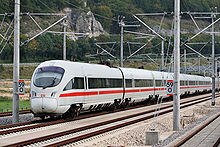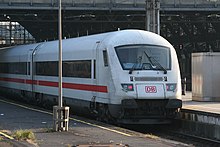Wire train bus
The Wire Train Bus (WTB) is a field bus that, together with the Multifunction Vehicle Bus (MVB), forms the Train Communication Network (TCN). It is used in the railroad and ensures communication between individual rail vehicles.
History of origin
In the railways to increase the productivity of the rolling stock are increasingly trainsets and pull trains used in freight double header instead preload operation (saves the engineer in the second Lok). Computer-controlled components are also being used more and more in railway vehicles. The include the heating and air conditioning , on-board power converters and the closed toilet facilities. This is why modern rolling stock needs a way to remotely control an entire train from a driver's cab or the train attendant's compartment. Several remote control applications (traction / braking, door control, diagnostics, air conditioning, passenger information, etc.) should be handled using a uniform system if possible.
That is why the WTB was developed and standardized by the IEC as IEC61375 and by the UIC as UIC Leaflet 556.
application

The WTB is installed in many modern railway vehicles, especially if they have an automatic coupling. In Germany he is z. B. in the ICE 3 , ICE-T , ICE-TD, the multiple units of the series 423 in the railcars of the series 640-644, but also in use on trams ( Stadtbahn Stuttgart ).
Long-distance passenger coaches with WTB in Germany have been around since the Metropolitan Express Train, a DB wagon train concept, went into operation . Since the wagon trains were equipped with the WTB- (MET), four (multiple unit) locomotives of the 101 series , the "M" version , are also equipped with the WTB- (MET).
The WTB-IC was retrofitted on the DB AG locomotives, in the 101 series of the "S" version, and later also the "E" version, as an FIS control and the side-selective door control.
For vehicles that do not run in fixed multiple units, the 18-pole double-coupled UIC cable is usually used for the WTB . The wire pairs 17 and 18 are used for WTB signal transmission between the vehicles. This form of application is used in Switzerland for commuter trains that are formed with the Re 460 as a locomotive (commuter trains made of EW-IV , EC and IC2000 wagon material).
Technical parameters
The Wire Train Bus can be communicated electrically via twisted pair or optically via fiber optics. The standard version with a UIC connector has shielded twisted pair cabling. A digital RS-485 transmission with 1 Mbit / s data rate is used physically . The coding is carried out using Manchester II channel code and HDLC block protection. A maximum of 32 nodes can be connected over a maximum length of 860 meters (without repeater ). The structure with a maximum of 1024 bit user data per telegram allows response times of typically 100 µs.
Individual evidence
- ^ Daniel Riechers: S-Bahn Multiple Units - New Vehicles for Germany's City Express Transport . 1st edition. transpress, Stuttgart 2000, ISBN 3-613-71128-1 , p. 60 .
- ↑ Hubert Kirrmann: Train Communication Network IEC 61375-4 Wire Train Bus. (Powerpoint; 1.0 MB) (No longer available online.) École Polytechnique Fédérale de Lausanne (EPFL), January 20, 1999, archived from the original on June 16, 2011 ; accessed on October 7, 2011 (English). Info: The archive link was inserted automatically and has not yet been checked. Please check the original and archive link according to the instructions and then remove this notice.
swell
- Operating manual IC2000 and FDV

